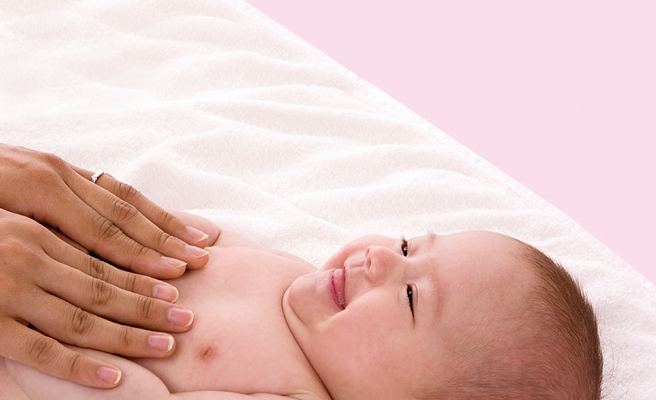Long before babies are able to speak, they communicate with the world around them through touch. The power of touch to soothe and heal is instinctive. If a baby cries, for example, we often cuddle them or stroke their back. Massaging your baby is an extension of this natural impulse.
You can start baby massage from birth though if your baby was premature, you may be advised to wait until they reach their due date. It’s usually better to wait until your baby is about six weeks old before going to a group session for baby massage, as very young babies can find the environment a little too busy and overwhelming.
Benefits of baby massage
There are lots of benefits to baby massage including:
- Being a great way of affirming your bond with your baby.
- Helping you become more confident in handling your child and better at recognizing their needs.
- Research has shown that baby massage can help a mother have a positive interaction with her baby.
- It can be a great way for partners, grandparents and siblings to bond with the newest addition to the family.
- Regularly massaging your baby may help them to sleep and settle better too. Your baby’s muscles relax, and breathing becomes deeper as massage raises levels of the ‘feel-good’ hormone oxytocin in both you and your baby. This helps you both feel calmer and relaxed. (This can also help with breastfeeding).
Although massage is beneficial for all babies, it is particularly useful for those with special needs, such as Down’s syndrome or cerebral palsy, as it provides a unique way of communicating and soothing them.
Creating a relaxing environment for baby massage
Here are some tips to help you try baby massage at home:
- Choose a time when your baby is content and alert, not tired or hungry.
- Try sitting on the floor, bed or sofa, with your child safely on a towel in front of you.
- Find a position that’s comfortable, gives you good eye contact with no overhead lights and where your baby is warm.
- It’s up to you whether your child is nappy-free, but it can help to at least loosen the nappy when massaging the tummy.
- There are lots of lovely baby massage oils on the market but cold-pressed sunflower oil, is perfectly adequate..
- Your child may end up with some oil in their mouth, so you really want to make sure it’s safe
It can be a nice idea to introduce a massage after bath and before bed as part of a bedtime wind-down.
How to massage your baby: getting started
Before beginning, ‘ask permission’ by rubbing a little oil between your hands near your baby’s ears, and ask ‘can I give you a massage?’ This may sound a little strange but your child will become familiar with this cue and know that massage is about to start. It also gives your baby a chance to let you know if they’re not feeling like a massage.
It’s great to massage the whole of your child’s body using a range of techniques. To get you started, we describe some strokes below for the legs and feet. You can repeat each stroke a few times, always responding to what your child seems to enjoy.
- Once you have ‘asked permission,’ gently hold one of your baby’s legs between your palms.
- Then, with one hand, hold your baby’s ankle securely. Mould your other hand around the top of your child’s thigh, then slide it down the leg towards the ankle. Aim for a ‘milking’ action – as if you were milking a cow!
- Then swap hands and repeat. Always keep your child’s ankle supported and use slow, flowing strokes.
- Next, cradle your child’s foot in your hands and use your thumbs to stroke over the sole of the foot from heel to toes, one thumb after another. This can also be done on the top of the foot. Gently squeeze and rub each toe between your thumb and finger.
- Then, holding your child’s foot in your hands, press the pads of your thumbs all over the sole of the foot, like a cat padding a cushion.
- Finish by repeating the ‘milking’ stroke in the opposite direction, i.e. from ankle to thigh.
Here are some tips to help you massage your baby safely:
- Avoid using oils that are scented, petroleum-based or contain nuts, as some oil might get into your baby’s mouth.
- When massaging your child’s arms or legs, always support the ankle or wrist with one hand.
- When massaging your child’s tummy with a circular motion, go clockwise rather than anti-clockwise.
Importantly, if your child becomes upset or falls asleep, stop massaging.
Enjoy baby massage
If your baby doesn’t seem to enjoy massage right away, don’t be downhearted. It’s a new experience for you both and it can take a bit of getting used to. Try a few minutes the first time and build up as your child gets more used to it.
There’s no reason why you can’t continue massaging your child into later childhood. Studies show this can have a positive effect, not just on your child’s physical health, but on their emotional wellbeing and relationships with others – including you!

